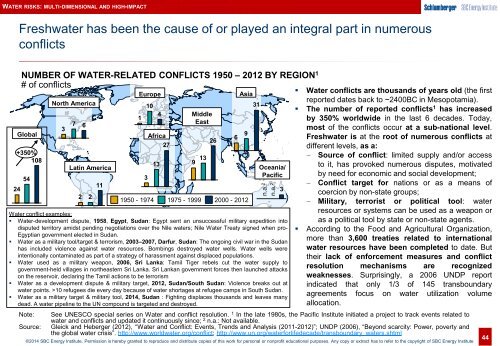1wMF53w
1wMF53w
1wMF53w
You also want an ePaper? Increase the reach of your titles
YUMPU automatically turns print PDFs into web optimized ePapers that Google loves.
WATER RISKS: MULTI-DIMENSIONAL AND HIGH-IMPACT<br />
Freshwater has been the cause of or played an integral part in numerous<br />
conflicts<br />
44<br />
NUMBER OF WATER-RELATED CONFLICTS 1950 – 2012 BY REGION 1<br />
# of conflicts<br />
Global<br />
+350%<br />
108<br />
24<br />
54<br />
Note:<br />
Source:<br />
North America<br />
3<br />
7<br />
6<br />
Latin America<br />
2<br />
2<br />
11<br />
Europe<br />
1<br />
3<br />
10<br />
Africa<br />
27<br />
13<br />
Middle<br />
East<br />
Asia<br />
Oceania/<br />
Pacific<br />
Water conflict examples:<br />
• Water-development dispute, 1958, Egypt, Sudan: Egypt sent an unsuccessful military expedition into<br />
disputed territory amidst pending negotiations over the Nile waters; Nile Water Treaty signed when pro-<br />
Egyptian government elected in Sudan.<br />
• Water as a military tool/target & terrorism, 2003–2007, Darfur, Sudan: The ongoing civil war in the Sudan<br />
has included violence against water resources. Bombings destroyed water wells. Water wells were<br />
intentionally contaminated as part of a strategy of harassment against displaced populations.<br />
• Water used as a military weapon, 2006, Sri Lanka: Tamil Tiger rebels cut the water supply to<br />
government-held villages in northeastern Sri Lanka. Sri Lankan government forces then launched attacks<br />
on the reservoir, declaring the Tamil actions to be terrorism<br />
• Water as a development dispute & military target, 2012, Sudan/South Sudan: Violence breaks out at<br />
water points. >10 refugees die every day because of water shortages at refugee camps in South Sudan.<br />
• Water as a military target & military tool, 2014, Sudan : Fighting displaces thousands and leaves many<br />
dead. A water pipeline to the UN compound is targeted and destroyed.<br />
4<br />
1950 - 1974 1975 - 1999 2000 - 2012<br />
9<br />
13<br />
26<br />
6<br />
9<br />
• Water conflicts are thousands of years old (the first<br />
reported dates back to ~2400BC in Mesopotamia).<br />
• The number of reported conflicts 1 has increased<br />
by 350% worldwide in the last 6 decades. Today,<br />
most of the conflicts occur at a sub-national level.<br />
Freshwater is at the root of numerous conflicts at<br />
different levels, as a:<br />
See UNESCO special series on Water and conflict resolution. 1 In the late 1980s, the Pacific Institute initiated a project to track events related to<br />
water and conflicts and updated it continuously since; 2 n.a.: Not available.<br />
Gleick and Heberger (2012), ‘‘Water and Conflict: Events, Trends and Analysis (2011-2012)”; UNDP (2006), “Beyond scarcity: Power, poverty and<br />
the global water crisis”. http://www.worldwater.org/conflict; http://www.un.org/waterforlifedecade/transboundary_waters.shtml<br />
©2014 SBC Energy Institute. Permission is hereby granted to reproduce and distribute copies of this work for personal or nonprofit educational purposes. Any copy or extract has to refer to the copyright of SBC Energy Institute<br />
31<br />
n.a. 2<br />
n.a. 2<br />
3<br />
<br />
<br />
Source of conflict: limited supply and/or access<br />
to it, has provoked numerous disputes, motivated<br />
by need for economic and social development;<br />
Conflict target for nations or as a means of<br />
coercion by non-state groups;<br />
Military, terrorist or political tool: water<br />
resources or systems can be used as a weapon or<br />
as a political tool by state or non-state agents.<br />
• According to the Food and Agricultural Organization,<br />
more than 3,600 treaties related to international<br />
water resources have been completed to date. But<br />
their lack of enforcement measures and conflict<br />
resolution mechanisms are recognized<br />
weaknesses. Surprisingly, a 2006 UNDP report<br />
indicated that only 1/3 of 145 transboundary<br />
agreements focus on water utilization volume<br />
allocation.<br />
44


